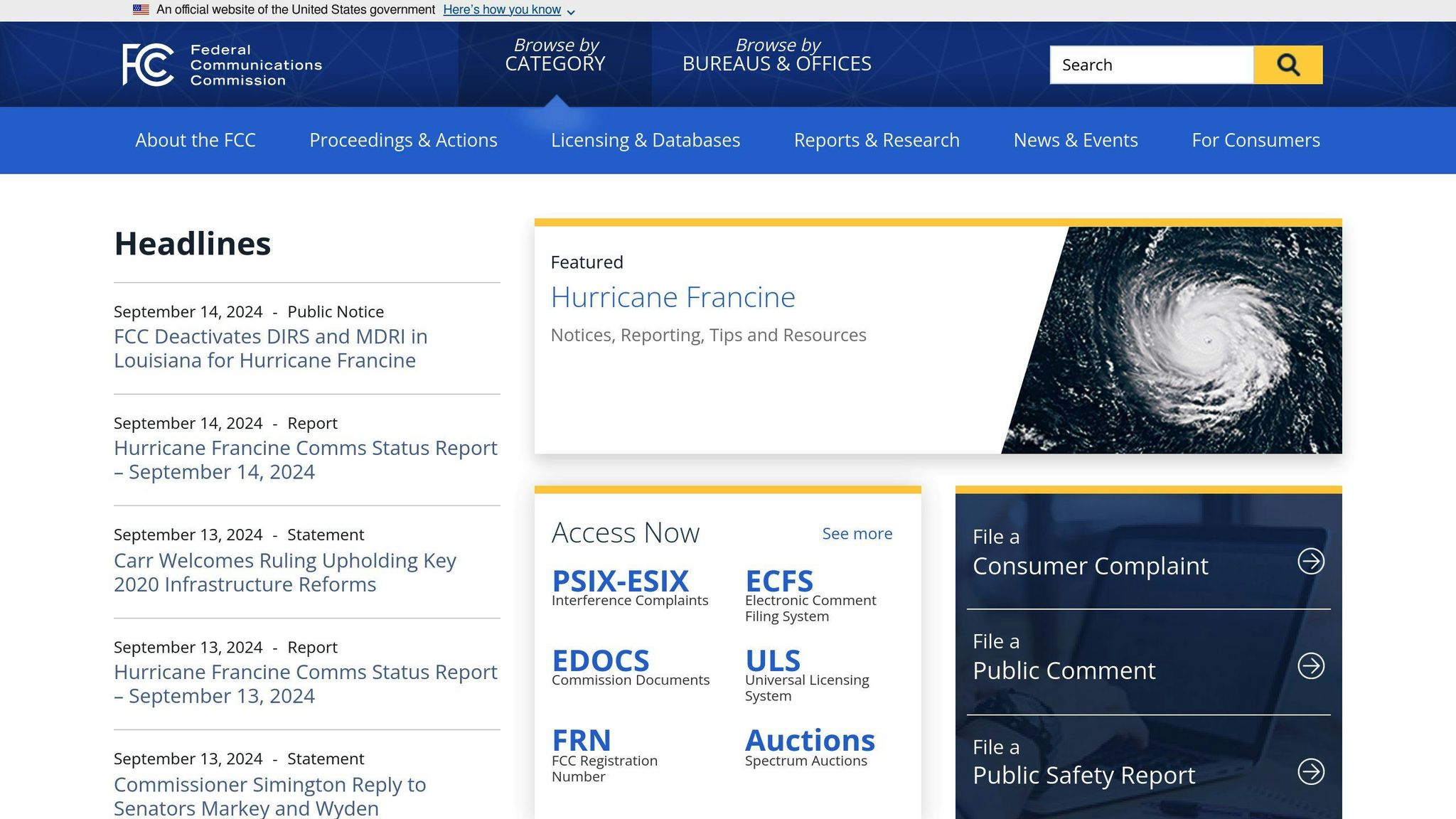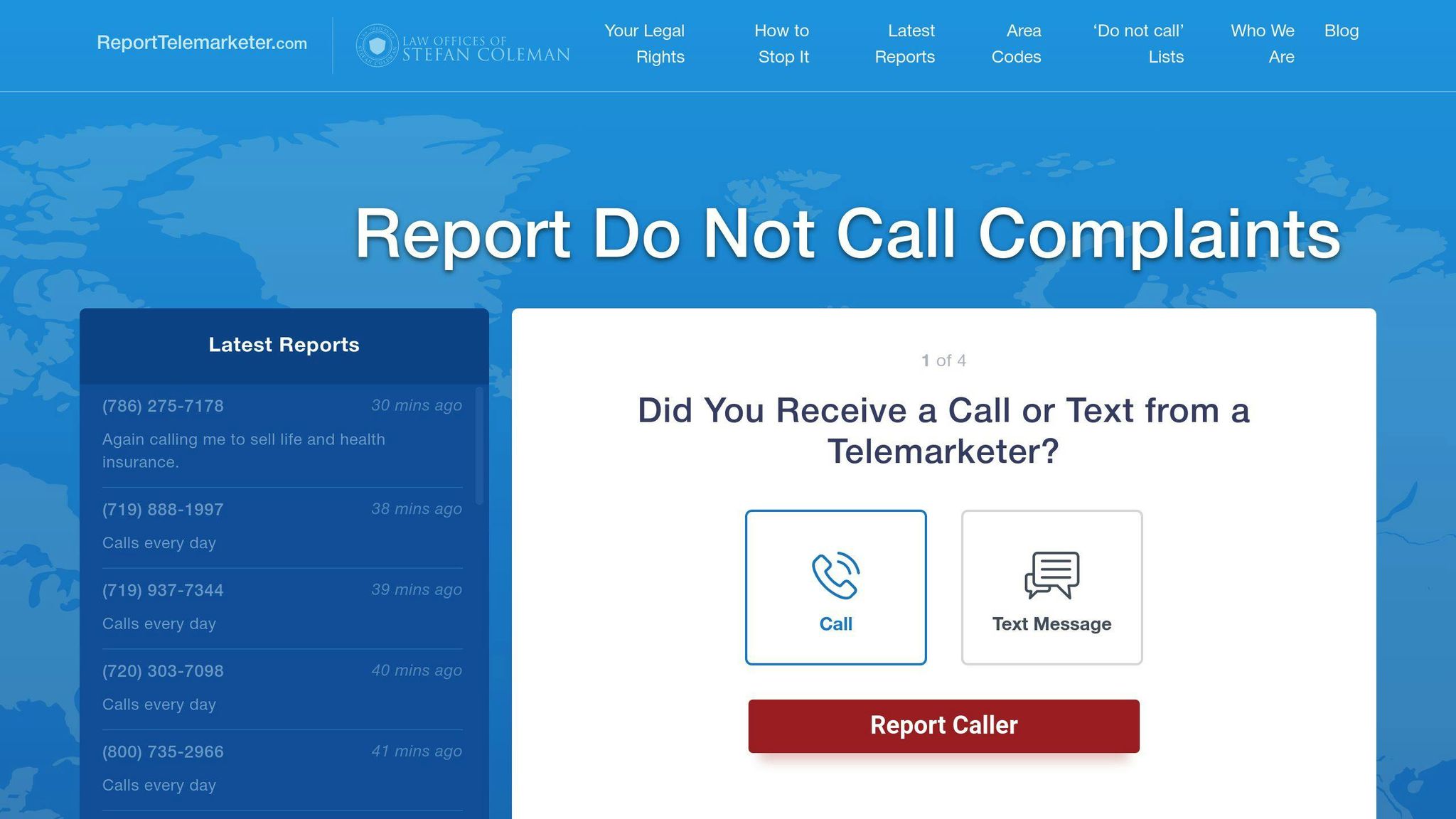
Unwanted telemarketing calls and texts can be frustrating. The FCC (Federal Communications Commission) makes it simple to report these violations and take action. Here’s how you can do it:
- What You Can Report: Robocalls, marketing texts, Do Not Call Registry violations, and auto-dialed calls without consent.
- Steps to File:
- Collect evidence (dates, times, messages, opt-out attempts).
- File online at fcc.gov/complaints, by phone (1-888-CALL-FCC), or by mail.
- What Happens Next: The FCC reviews your complaint, notifies the violator, and tracks repeat offenders to enforce penalties.
Filing is free (except for formal complaints). Your action helps protect your privacy and improves enforcement against illegal telemarketing.
How to File a Complaint with the Federal Communications Commission

Step 1: Types of Complaints the FCC Handles
Knowing what complaints the FCC handles will help you focus on violations they can act on, especially when it comes to stopping illegal telemarketing practices. The FCC deals with issues like robocalls, unsolicited texts, Do Not Call Registry violations, and auto-dialed calls made without permission. Violations happen when telemarketers break these rules – such as ignoring opt-out requests or contacting numbers listed on the Do Not Call Registry.
| Type of Call/Text | When It Violates the Rules |
|---|---|
| Automated Calls | Made without prior written consent |
| Marketing Texts | Sent using automated systems without permission |
| Live Sales Calls | Directed at numbers on the Do Not Call Registry |
| Recorded Messages | Missing clear opt-out options |
Laws That Protect You
The Telephone Consumer Protection Act (TCPA) sets guidelines to safeguard consumers:
- Requiring consent before using automated systems
- Respecting Do Not Call requests
- Restricting calls to between 8 AM and 9 PM in your local time zone
When telemarketers break these rules, the FCC uses complaints to track repeat offenders and take action. This can include hefty fines or cease-and-desist orders to stop illegal behavior.
Now that you understand what qualifies as a violation, let’s go over how to prepare your complaint for submission.
Step 2: Getting Ready to File Your FCC Complaint
Now that you understand what counts as a violation, it’s time to gather the evidence you’ll need to support your complaint.
Collecting Evidence
Make sure to document the following details about the unwanted calls or texts:
| Information Needed | What to Include |
|---|---|
| Call/Text Details | Date, time, and how often contact occurred |
| Communication Content | Transcript or a brief summary of the message |
| Opt-out Attempts | Dates and methods used to request removal |
| Do Not Call Status | Date you registered your number (if applicable) |
Here’s how to prepare your case:
- Record Key Details: Write down the dates, times, and frequency of the calls or texts. Save screenshots of text messages and recordings of automated calls (if your state allows it). Keep any written correspondence with the telemarketer.
- Document Opt-out Efforts: Note when and how you asked to stop receiving messages or calls. Save any confirmation emails or messages about your request. If they kept contacting you after you opted out, make sure to document those instances.
- Stay Organized: Arrange everything in chronological order to clearly show repeated violations. Keep these records for at least six months in case you need them later.
Once your evidence is sorted, you’re ready to file your complaint with the FCC.
Step 3: How to File Your Complaint
Once you’ve gathered your evidence, it’s time to file your complaint with the FCC. Here’s how you can do it.
Filing Online Through the FCC Consumer Complaint Center
Head to fcc.gov/complaints, choose "Unwanted Calls", and fill out the form. You’ll need to provide:
| Required Information | Details Needed |
|---|---|
| Personal Details | Your name and contact information |
| Company Information | Name and address of the telemarketer |
| Incident Details | Dates and specifics of the violations |
| Resolution Desired | What outcome you’re seeking (e.g., stop the calls, investigate the telemarketer) |
| Evidence | Attach the documentation you collected in Step 2 |
Filing by Phone or Mail
If you prefer not to file online, you can submit your complaint via phone or mail.
By Phone:
- Call 1-888-CALL-FCC (1-888-225-5322)
- For ASL users: 1-844-432-2275
- Have your evidence ready before calling.
By Mail:
Send your complaint to:
Federal Communications Commission
Consumer and Governmental Affairs Bureau
Consumer Inquiries and Complaints Division
45 L Street NE
Washington, DC 20554
Be sure to include a detailed statement of the facts and copies (not originals) of your supporting documents.
Important: Filing a standard complaint is free, but formal complaints come with a $605.00 fee. Most issues can be handled through the free process.
After submitting your complaint, the FCC will review and process it. Next, we’ll look at what happens after filing.
sbb-itb-a8d93e1
Step 4: What Happens After You File?
How the FCC Handles Complaints
After you file, the FCC will send you an acknowledgment along with a tracking number. Here’s a breakdown of what happens next:
| Stage | What Happens |
|---|---|
| Initial Review (1-7 days) | FCC reviews your complaint and notifies the service provider. |
| Provider’s Response (30 days) | The company must provide a written response to the FCC. |
| FCC Review | The FCC evaluates the response and decides on further actions. |
During the process, the FCC might reach out to you for additional details. While they don’t directly resolve individual complaints, the information you provide helps them:
- Shape policies to protect consumers.
- Monitor violations and guide enforcement actions.
- Create new measures to safeguard against future issues.
Tracking Your Complaint Status
You can keep tabs on your complaint’s progress in several ways:
- Online Portal: Use your tracking number to check the status.
- Email Notifications: Stay updated with key developments sent straight to your inbox.
- Direct Contact: Speak with an FCC representative for updates.
"If consumers are not satisfied with the response to their informal complaint, they can file a formal complaint with the FCC within six months of the response date".
For additional support, services like ReportTelemarketer.com can help investigate violations and assist with filing formal complaints.
While the FCC works to address violations, you can also explore other tools to reduce unwanted calls.
Step 5: Other Tools to Stop Telemarketing Calls
In addition to filing FCC complaints, you can use tools like the Do-Not-Call Registry, call-blocking apps, and legal services to tackle telemarketing calls. These tools can cut down on unwanted calls, but pairing them with formal complaints can make your efforts more effective.
| Tool Type | Purpose | Key Benefits |
|---|---|---|
| Do-Not-Call Registry | Prevention | Requires telemarketers to stop calling legally |
| Call Blocking Apps | Active Defense | Automatically filters and blocks suspicious calls |
| Legal Services | Enforcement | Takes action against persistent violators |
Using ReportTelemarketer.com

If standard tools aren’t enough, ReportTelemarketer.com offers another layer of protection. This free service investigates violations and pursues legal action at no cost to you. It’s designed to complement FCC complaints by directly targeting violators through legal channels.
Led by consumer protection attorney Stefan Coleman, their team handles every step of the process. Attorney fees are recovered from violators, so you don’t pay out of pocket.
For the best results, combine multiple tools. Register with the Do-Not-Call Registry, file FCC complaints, and consider services like ReportTelemarketer.com to build a strong defense against telemarketers.
Conclusion: Protecting Your Privacy and Stopping Telemarketers
Filing a complaint with the FCC is a key step in addressing unwanted telemarketing calls. The FCC takes these complaints seriously, using them to enforce consumer protection laws and crack down on illegal practices. By combining this with other tools, you can strengthen your efforts to stop persistent calls.
The FCC’s complaint process is simple and free. Most issues can be resolved by submitting an informal complaint through their online portal at fcc.gov/complaints for quicker processing.
While waiting for the FCC to act, consider using services like ReportTelemarketer.com to explore additional legal options. Taking a multi-faceted approach improves your chances of putting an end to these intrusive calls. Filing complaints not only safeguards your privacy but also contributes to the fight against illegal telemarketing.
For more details on how the FCC complaint process works, check out the FAQs below.
FAQs
Does filing a FCC complaint work?
Filing a complaint allows the FCC to monitor violations, investigate repeat offenders, and enforce telemarketing regulations. If they can’t resolve your issue directly, they’ll guide you to the right agency for assistance.
How do I report telemarketers to the FCC?
You can report telemarketers through the FCC’s online portal at fcc.gov/complaints. This is the fastest method, but you can also file by phone at 1-888-CALL-FCC or send your complaint by mail. Make sure to include details about the telemarketer, a summary of what happened, and what outcome you’re seeking.
Does filing a complaint with the FCC do anything?
"The collective data we receive from complaints helps us keep a pulse on what consumers are experiencing, may lead to investigations and serves as a deterrent to the companies we regulate." – FCC
Your complaint contributes to enforcement actions. The FCC uses this data to track trends, investigate potential violations, and inform policy decisions. While individual cases may not always be resolved, every complaint helps strengthen consumer protections and oversight of telecom companies.